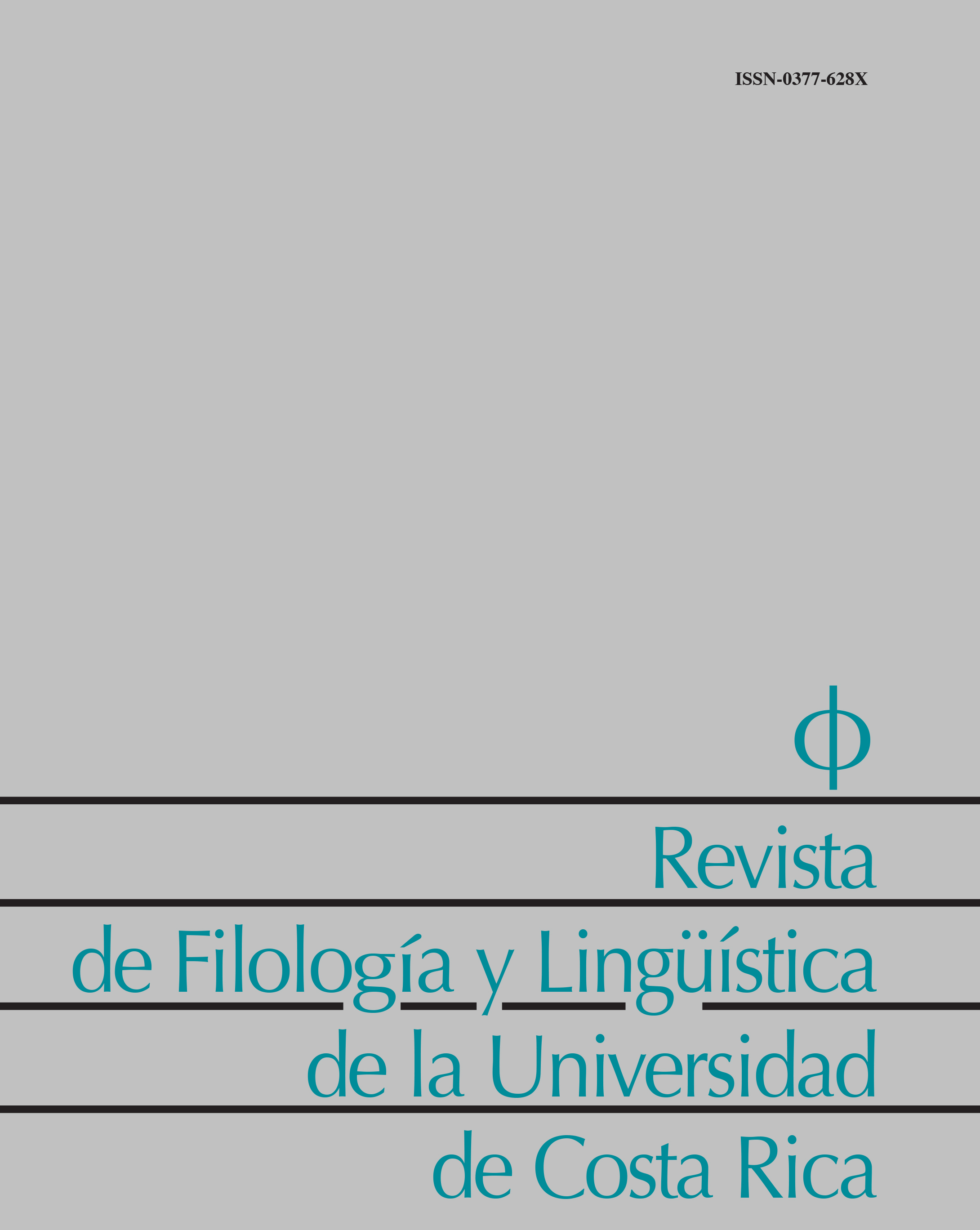Abstract
El uso de elementos lingüísticos prototípicamente asociados con el espacio físico para aludir al tiempo constituye un reflejo de la metáfora conceptual tiempo es espacio. El presente artículo examina y categoriza las diferentes manifestaciones de dicho fenómeno en español. La indagación abarca el empleo temporal de palabras que prototípicamente marcan la dimensionalidad de referentes concretos, la transferencia de elementos deícticos del dominio espacial al temporal, la expresión de las unidades de tiempo como si formaran una secuencia de objetos y la conceptualización del tiempo como movimiento.
Literaturhinweise
Brzozowska-Zburzyńska, B. (2009). Uso temporal de algunos marcadores de localización espacial en español y en francés. Études Romanes de Brno. 30 (2), 213-220.
Bylund, E. y Andersson Konke, L. (2015). Las metáforas espacio-temporales y la percepción del tiempo: un estudio comparativo sobre el español y el sueco. En G. Engwall y L. Fant (Eds.). Festival Romanistica. Contribuciones lingüísticas–Contributions linguistiques –Contributi linguistici–Contribuições linguísticas. (pp. 113-130). Estocolmo: Stockholm University Press.
Casasanto, D., Boroditsky, L., Phillips, W., Green, J., Goswani, S., Bocanegra-Thiel, S., Santiago-Diaz, I., Fotokopoulo, O., Pita, R. y Gil, D. (2004). How deep are the effects of language on thought? Time estimation in speakers of English, Indonesian, Greek, and Spanish. Proceedings of the Annual Conference of the Cognitive Society. 26, 186-191.
Evans, V. (2007). How we conceptualise time: language, meaning and temporal cognition. En V. Evans, B. Bergen y J. Zinken (Eds.). The Cognitive Linguistics Reader. (pp. 733-764). Londres: Equinox.
Evans, V. (2013). Language and Time: A Cognitive Linguistics Approach. Cambridge: Cambridge University Press.
Flaherty, M. (1999). A Watched Pot: How We Experience Time. Nueva York: New York University Press.
Frawley, W. (1992). Linguistic Semantics. Hillsdale, Nueva Jersey: Lawrence Erlbaum Associates.
García-González, F. D. (2006). La expresión de tiempo en las locuciones adverbiales en español. (Trabajo de investigación). Universidad de Alicante.
Grady, J. E. (1997a). Foundations of Meaning: Primary Metaphors and Primary Scenes. (Tesis doctoral). University of California, Berkeley.
Grady, J. E. (1997b). Theories are buildings revisited. Cognitive Linguistics. 8 (4), 267-290.
Heine, B., Claudi, Ü y Hünnemeyer, F. (1991). From cognition to grammar: Evidence from African languages. En E. C. Traugott. y B. Heine. (Eds.). Approaches to Grammaticalization, vol. 1. (pp. 149-188). Ámsterdam: John Benjamins.
Lakoff, G. (1993). The contemporary theory of metaphor. En A. Ortony. (Ed.). Metaphor and Thought (2 ed.). (pp. 202-251). Cambridge: Cambridge University Press.
Lakoff, G. y Johnson, M. (1980). Metaphors We Live By. Chicago: The University of Chicago Press.
Landau, B.y Jackendoff, R. (1993). “What” and “where” in spatial language and spatial cognition. Behavioral and Brain Sciences 16, 217-265.
Muñoz-Acevedo, D. (2003). Esquemas locativos preposicionales: configuración semántica de las preposiciones in, on y at del inglés y en del español. Lenguas Modernas. 28-29, 275-311.
Naber, G. L. (2012). The Geometry of Minkowski Spacetime: An Introduction to the Mathematics of the Special Theory of Relativity. (2 ed.). Nueva York: Springer.
Radden, G. (2003). The metaphor time as space across languages. Zeitschrift für Interkulturellen Fremdsprachenunterricht. 8 (2/3), 226-239.
Rhee, S. (2004). Semantic structure of English prepositions: an analysis from a grammaticalization perspective. Language Research. 40 (2), 397-427.
Ruiz Gurillo, L. (2012). Espacio y tiempo en las locuciones adverbiales del español. En C. Sinner, E. Tabares Plasencia y E. T. Montoro del Arco (Eds.). Tiempo, espacio y relaciones espacio-temporales en la fraseología y paremiología españolas. (pp. 153-169). München: Peniope. Recuperado de https://rua.ua.es/dspace/bitstream/10045/24055/1/2012_Leonor_Ruiz_Peniope.pdf
Sakran Dawood Alkarhi, A. (2017). El enfoque cognitivo conceptual de tiempo en la metáfora: Un estudio comparativo entre árabe y español. (Tesis doctoral). Universidad de Granada.
Talmy, L. (1983). How language structures space. En H. Pick y L. Acredolo (Eds.). Spatial Orientation: Theory, Research, and Application. (pp. 225-282). Nueva York: Plenum Press.
Waluch-de la Torre, E. (2007). Análisis comparado de las preposiciones espaciales en español, portugués y polaco. (Tesis doctoral). Universidad de Varsovia y Universidad de Granada.
Yu, N. (1998). The Contemporary Theory of Metaphor: A Perspective from Chinese. Ámsterdam: John Benjamins.
Zieliński, A. (2012). Gramaticalización de las expresiones espacio-temporales en español: el caso de las perífrasis de los verbos de movimiento. Verba Hispanica. 20 (1), 431-454.

